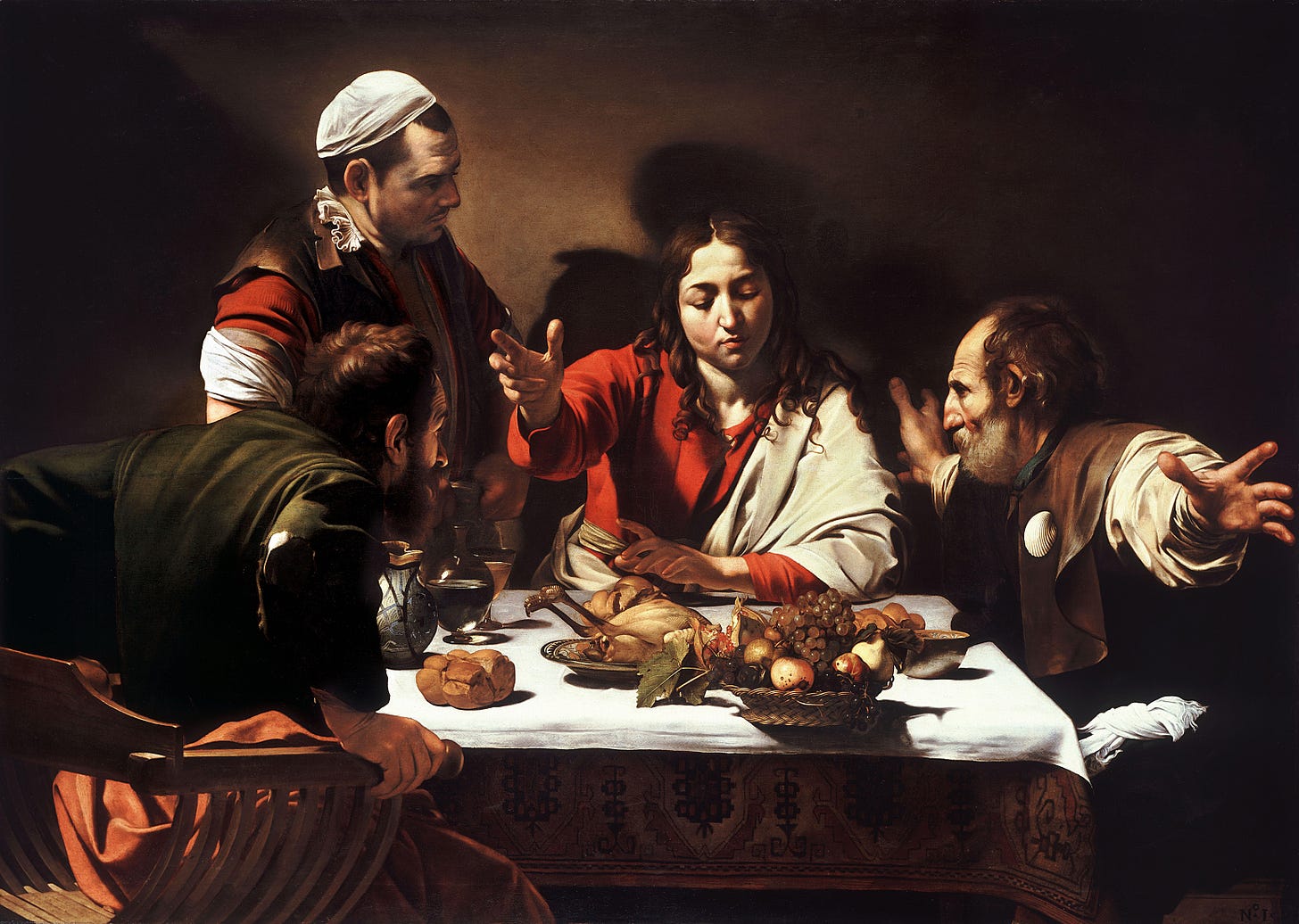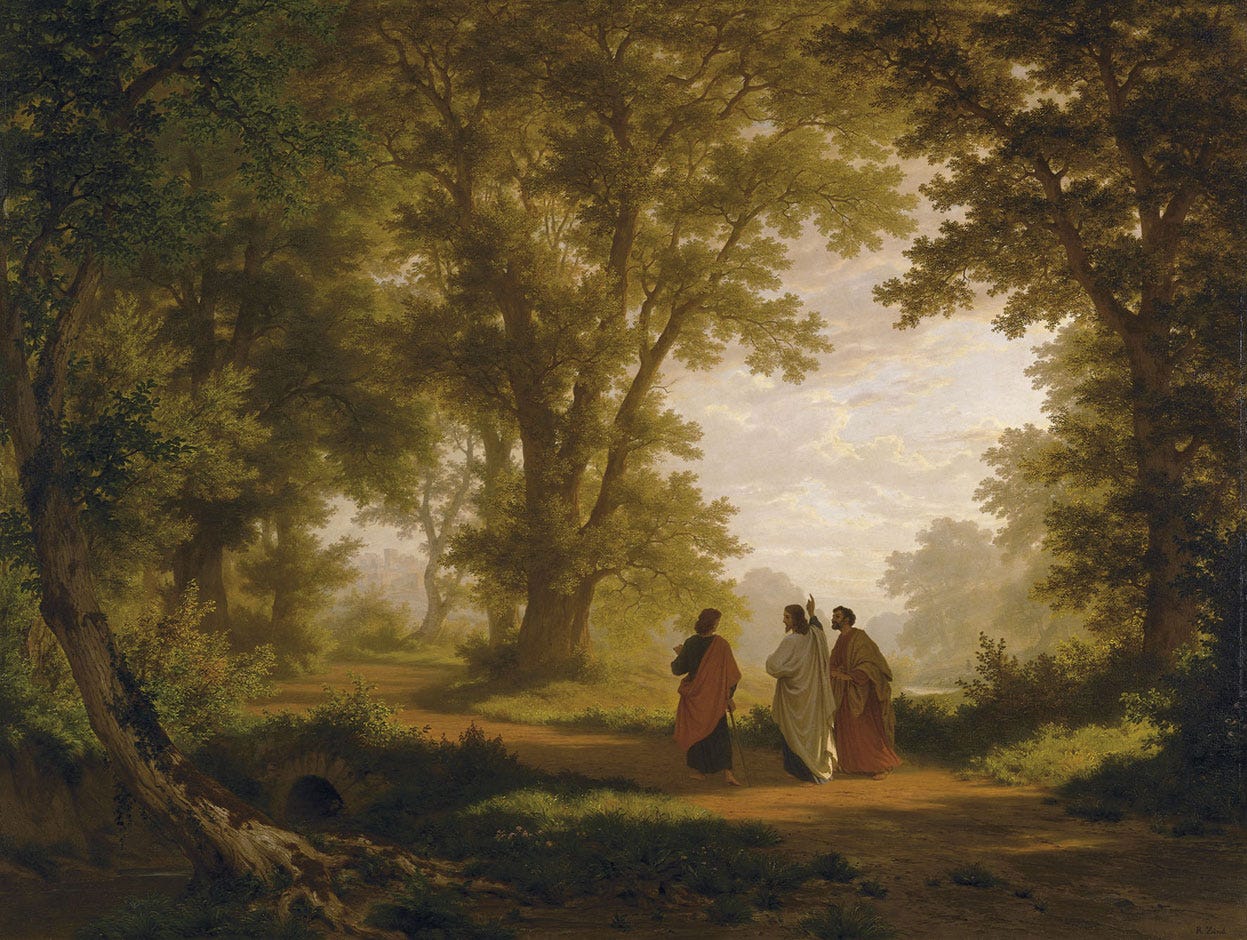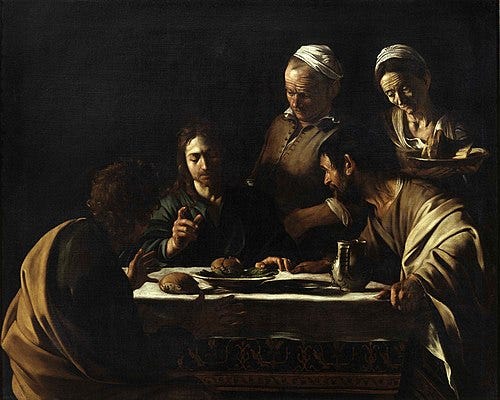Audio Post: (Prayer included at the end.)
The road to Emmaus is one of the more famous resurrection stories. Luke is the only Gospel writer to tell it, perhaps because it fits his motif of the journey so well. Beginning in Luke chapter nine until the crucifixion, Jesus has been on his journey to Jerusalem and the cross. With the Emmaus story, we see that Jesus’ journey continues, now into the new creation. Luke makes this point more explicitly at the beginning of Acts, the second of his volumes, when he references his Gospel account as the “beginning” of what Jesus came to do and teach. Acts is the continuation of Jesus’ work, now through the Spirit and those who follow Jesus.
Luke tells the story. The women return from the empty tomb having heard from angels that Jesus is not there. He has been raised, just as he said! Peter goes to investigate. (John tells us that he went with him) but they encounter no angels. They do see an empty tomb but no body, only “strips of linen lying by themselves.” Then the scene shifts rapidly to two friends who are on their way to Emmaus, a town about 7 miles away. We find out later that these friends have been with the disciples and heard the women’s report but are now, some time later, on their way home. Perhaps they had family to return to. The Passover feast was over and pilgrims to Jerusalem would be on their way back to their homes. Luke gives no explanation as to why they are on the road.
These two, Cleopas and an unnamed companion, perhaps his wife, are walking along discussing everything that has happened. They are disillusioned and confused. None of this was what they had been expecting of Jesus. How relatable is that? How often do we find ourselves confused, distraught, even, when things are not turning out the way we hope. We turn to God and ask our “why’s” and our “how come’s” when all the while, Jesus might be right there walking beside us.
I want to briefly touch down on three elements of this story that catch my attention. Perhaps you notice them as well: the context of a meal, the opening of the eyes, and the singling out of Peter.
Luke’s Meals
Luke must have loved his food! There are more scenes with meals in his Gospel then in any of the others. I have read there are as many as 19 meals mentioned (I haven’t counted) but there is general agreement that seven are primary. I do not want to take the time to go through them all but the references are 5:29, 7:36, 9:16, 10:40, 11:37, 14:1, and 22:14 – seven meals, the last one being the Last Supper. Eating together in that culture was symbolic of relationship, community, kinship. Families gathered over meals. Strangers were invited to share meals. It was a mark of being a God honoring person, Luke reveals Jesus participating in this community food-sharing seven times. There is a completeness to his hospitality.
But now, at the home of these two friends, in the village of Emmaus, an eighth meal – the beginning of a new day, a new week, a new creation. The meals of the old creation are finished. Seven meals points to their completeness. Now, new creation is here. And Jesus offers a new meal. But it is not just any meal. It is a meal that reverses the damage done at the first meal.
“Their Eyes Were Opened”
When Adam and Eve take and eat of the forbidden fruit – a kind of meal, you might say – their eyes are opened. But this is not a good thing. Because they eat alone, apart from their Father and without his permission, their opened eyes are a sign of a ruptured relationship. They are immediately swamped with shame and fear. Their opened eyes take them into hiding and out of relationship. But now, as Jesus sits before these friends on this first day of new creation, he hosts a new meal, he breaks the bread with wounded hands, blessing it and offering it, and their eyes are opened.
They recognize Jesus for the first time. The fateful meal in Eden is reversed. Their eyes are opened not to chase them into isolation and fear but opened to see Jesus, the one who has dealt a death blow to fear and shame.
This is the second time this has happened in these resurrection stories. You may recall that Mary, weeping in the garden, also does not recognize Jesus at first. In that story, John gives this detail so as to allow him to reference Jesus as the Gardener tending his garden. That is who Mary thinks he is at first. This is one of the ways John points his readers back to the first creation story and that first garden, helping us see that New Creation has come in Jesus. Luke is doing a similar thing here.
The Singling Out of Peter
The final piece of this story that catches my attention is the odd little reference to Peter. In verse 34, when the two friends make their way back to the disciples to share that they have seen Jesus, they say, “It is true! The Lord has risen and has appeared to Simon.” It’s a bit odd because Luke has not told us of an appearance to Simon (Peter). When did this happen? We are not told, but he is not the only one to do this. Paul does it as well, in 1 Corinthians 15:5 where he recounts the resurrection appearances of Jesus, “he appeared to Cephas (Peter), and then the Twelve.” In Mark 16:7, the angel at the tomb says to the women, “Go tell his disciples, and Peter.”
Why this singling out of Peter? Most likely it is because of the tragedy in the courtyard – Peter’s worst moment, his denial of Jesus. Jesus steps into Peter’s deepest shame and offers grace. The point is not the detail of when he found Peter, but that he did! I wonder how Jesus is looking for you this Easter season?
I will close with this, one of my favorite resurrection poems, by Eugene Warren, Christographia 31[1]
Christographia 31
Christ came juggling from the tomb,
flipping and bouncing death’s stone pages,
tossing those narrow letters high
against the roots of dawn spread in cloud.
This Jesus, clown, came dancing
in the dust of Judea, each slapping step
a new blossom spiked with joy.
Hey! Listen – that chuckle in the dark,
that clean blast of laughter behind –
Christ comes juggling our tombs,
tossing them high and higher yet,
until they hit the sun and break open
and we fall out, dancing and juggling
our griefs like sizzling balls of light.
Amen and amen! If you would like to pray with this story, you can do so here, or on Spotify, Apple Podcasts and Amazon Music podcasts, under The Friendship with Jesus Podcast.
[1] Eugene Warren, in Luci Shaw, ed. Widening Light: Poems of the Incarnation, 117
A worship song this week - maybe you’ve sung it - Gratitude. Enjoy!







